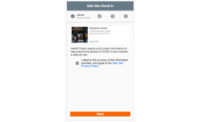Keeping track of construction progress is often a matter of waiting for engineers and site supervisors to walk the site and document it when they can. Getting that data into the general project pipeline is a challenge in itself.
“The manual process is tedious for us. It’s very time consuming to send personnel to the jobsite and track everything on job, marking it off on an iPad,” says Chad Krause, vice president of operations at general contractor Build Group. His firm had tried other work-tracking methods, but came across the Israel-based startup Buildots last year.
Founded in 2018, Buildots is able to take 360° images from hardhat-mounted cameras during jobsite walks and overlay them on a BIM digital twin to track ongoing progress. Buildots generates regular reports on work progress, and its machine-learning system can spot discrepancies in construction as they happen day-to-day, sending out alerts before they lead to delays. Used on projects in the Middle East, Asia and Europe, Build Group is Buildots’ first U.S.-based customer.
Working on the 19-story M2 residential tower in the 5M development in San Francisco, Build Group brought in Buildots early on in the process. This allowed them to fully integrate their work-progress tracking with the project’s BIM pipeline. “It took three or four months to collaborate back and forth and make sure the models got set up correctly,” says Krause. Build Group’s Navisworks models were linked up to digital twins built in Buildots’ Revit environment, and from there it was just a matter of having the designers detail the smaller design elements they would want tracked during construction.
“With most clients on the first project we do with them, we join when it’s already designed and construction starts in a month,” says Aviv Leibovici, Buildots co-founder and chief product officer. “So if we set up the system and find they didn’t model electrical sockets, we can’t track socket [installations]. With Build Group, it was the first case of ‘hey, let’s collaborate earlier during the design phase.’ We’ll do some more design work up front but it gets us that extra value.”
Once the Buildots digital twin is built, it is regularly checked against the daily 360° reality captures from the site. Two engineers were tasked with walking the site wearing the camera, and from there the rest is handled by Buildots’ system.
According to Krause, getting automated reports and alerts from Buildots helped break the cycle of information collected during site walks going unused. “The information would never get to the top, it would be stuck at the jobsite level,” he says. “We’re trying to free the information to make more informed decisions.”
“When you talk about boots on the ground—the engineers on site—probably the biggest benefit for them is that they don’t have to prepare presentations every week for the [executives and clients] worried about the schedule,” says Leibovici. “Suddenly you have all this time freed up to make the job run better.”
Buildots system can identify deviations from the model even on smaller elements.
Image courtesy of Buildots
Build Group’s pilot effort with Buildots on the M2 tower went so well over the last year that they now plan to use it on two new projects: a 60-story mixed-use tower in Seattle and a student housing project in San Francisco.
“Everyone likes to be better informed, from the GC to the subcontractors,” says Krause. “If there is a portion of the job that is falling behind, they’ll want to know about it. Anything we can do to improve efficiency on the GC and the subcontractor sides is generally a good thing.”
Buildots recently secured a $30-million Series B funding round, and plans to use the funds to double the size of its workforce. The startup is also planning to move beyond its initial focus on residential construction to branch out into other sectors with more complex projects, such as large infrastructure. Leibovici adds that they are looking to add new features to the system as well, including monthly payment requests triggered by work completion and integrations with widely used scheduling software such as Primavera.






Post a comment to this article
Report Abusive Comment